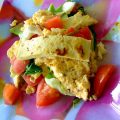 Low-fat recipesLight products«work» on the principle of inclusion: when we eat a product, we unconsciously appropriate its properties and expect to become slimmer. But because of the «lightness», we consider what we have eaten to be insignificant and increase the amount of food we consume. Which is completely natural: when the body does not receive enough calories, it requires more. In addition, we seem to receive an indulgence for some excesses: «Once for lunch I ate «light», and I can finally afford a piece of chocolate cake». How can I avoid falling into this trap? First of all, let's study some facts about «light» products and how they are made.Non-oily butterThe phrases «light butter», «light mayonnaise» mean that some of the animal components in this product have been replaced with plant ones. This allows the consumer to think that the product is "low-cholesterol", and the manufacturer to significantly reduce the cost of this product. "Light" butter has a lower fat content - up to 20-40% instead of 80%. Reducing the percentage of fat changes the consistency of the butter: it becomes softer. This allows it to be spread on bread in a thinner layer. But, on the other hand, reducing fat content comes at the expense of the creamy taste, and we do not get the expected satisfaction from it. Calculations change everything
Low-fat recipesLight products«work» on the principle of inclusion: when we eat a product, we unconsciously appropriate its properties and expect to become slimmer. But because of the «lightness», we consider what we have eaten to be insignificant and increase the amount of food we consume. Which is completely natural: when the body does not receive enough calories, it requires more. In addition, we seem to receive an indulgence for some excesses: «Once for lunch I ate «light», and I can finally afford a piece of chocolate cake». How can I avoid falling into this trap? First of all, let's study some facts about «light» products and how they are made.Non-oily butterThe phrases «light butter», «light mayonnaise» mean that some of the animal components in this product have been replaced with plant ones. This allows the consumer to think that the product is "low-cholesterol", and the manufacturer to significantly reduce the cost of this product. "Light" butter has a lower fat content - up to 20-40% instead of 80%. Reducing the percentage of fat changes the consistency of the butter: it becomes softer. This allows it to be spread on bread in a thinner layer. But, on the other hand, reducing fat content comes at the expense of the creamy taste, and we do not get the expected satisfaction from it. Calculations change everything An indicator such as fat percentage canmay be misleading, because "fat content" is not an absolute concept, but a relative one. For example, on the packaging of mascarpone cheese the frightening figure "80% fat content" is indicated - it automatically falls into the list of products that are too fatty. But if you look more closely, we will find a clarifying "in relation to dry matter". And where the percentage of fats, proteins and carbohydrates in 100 g of the product is indicated, "40 g of fat" appears. That is, in fact, this product with a 40% fat content is no fatter than some types of hard cheeses. The same rule applies to cottage cheese and homemade cheese, in which the fat content of 20% (in relation to dry matter) turns into 4 grams of fat per 100 g of product - almost as in normalized milk (3.6%). It is wiser to focus on the calorie content. For example, 100 g of sour cream with 15% fat content contains about 170 kcal. Classic mayonnaise - 650 kcal, and low-calorie - 480 kcal. Judge for yourself - it is better to choose sour cream.
An indicator such as fat percentage canmay be misleading, because "fat content" is not an absolute concept, but a relative one. For example, on the packaging of mascarpone cheese the frightening figure "80% fat content" is indicated - it automatically falls into the list of products that are too fatty. But if you look more closely, we will find a clarifying "in relation to dry matter". And where the percentage of fats, proteins and carbohydrates in 100 g of the product is indicated, "40 g of fat" appears. That is, in fact, this product with a 40% fat content is no fatter than some types of hard cheeses. The same rule applies to cottage cheese and homemade cheese, in which the fat content of 20% (in relation to dry matter) turns into 4 grams of fat per 100 g of product - almost as in normalized milk (3.6%). It is wiser to focus on the calorie content. For example, 100 g of sour cream with 15% fat content contains about 170 kcal. Classic mayonnaise - 650 kcal, and low-calorie - 480 kcal. Judge for yourself - it is better to choose sour cream.

Making Money with Desserts: Success Stories
Evgeniya Polischuk (Fedutinova) instagram:@evgeniyafedutinovavk.com/janeshomebaking– It all started with baking for family and friends. Gradually, I started posting photos of my baked goods on Instagram – and orders started coming in. I made my first custom-made cake on October 13, 2014, and a little earlier I started making macaroons and cupcakes. You could say that the business “found me”, I am very […]

Soups are cold recipes with photos
Cold cucumber soup with yogurt and lemonsorbet from the chef of the restaurant La Taverna Alexander Zhurkin Photo: Getty Images Ingredients: Plain yoghurt – 125 g Cucumber – 150 g Lemon/lime sorbet – 50 g Cocktail shrimp – 24 g Fresh ginger juice – 1 g Lime juice – 5 g Fresh orange juice – 5 g Parsley – 1 g Pink pepper – 1 g Watercress – […]

barbeque kebab
Pork tenderloin in glaze Photo:Dmitry Bayrak/dbstudioPreparation time: 20 minutes + marinating time.Calories: 454 kcal per serving.For 4 servings: 4 pork tenderloins (approximately 300 g each), 1 onion, 2 cloves of garlic, 1 tsp. lemon zest, 1 tsp. lemon juice, a pinch of ground cumin, coriander and turmeric, 1 tbsp. vegetable […]

Pierre Duacan: dietary recipes: Ducane diet
Beetroot soup Photo:Season’S, Luxury Hotels RepresentationYou will need:· Boiled beetroot – 60 g· Fresh cucumbers – 20 g· Red radish – 20 g· Green onions – 10 g· Egg – 1 pc.· Drinking mineral water – 200 g· Salt – 1 gPreparation:· Boil the egg and beetroot.· Grate the cucumbers, radish and part of the beetroot. Put everything […]





